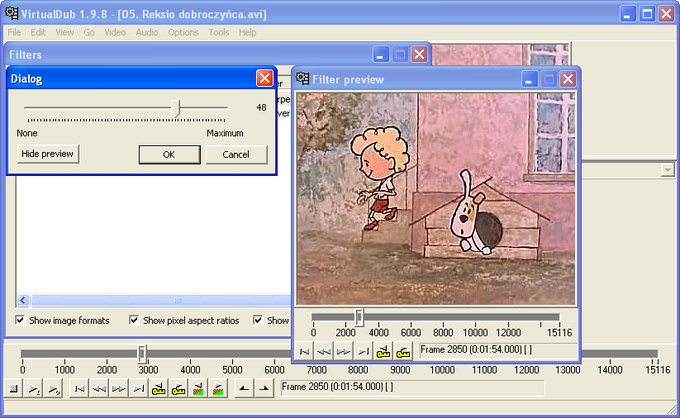
The second section focuses on the legality and ethics surrounding fansubs. A clear picture of the entire fansubbing process would allow a better understanding of the rest of issues covered in this paper. The first part of the paper offers a description of the people and stages involved in the fansubbing process, from beginning (source acquisition) to end (distribution). This study is based on the analysis of examples from both English and Spanish digital fansubs, but it could be very interesting to assess the impact of fansubs in other countries and cultures as well.
#VIRTUALDUB SUBTITLER FILTER 64 BIT PROFESSIONAL#
It also attempts to serve as a reflection on the unique features present in this type of amateur subtitling, which have been rarely seen in the professional field (Díaz Cintas, 2005). This study stems primarily from one of the author's experience as a fansubber and aims at presenting the working methodology usually followed when fansubbing. However, this phenomenon seems to have passed unnoticed to the academic community and there are very few studies about this new type of audiovisual translation (Ferrer Simo, 2005), with most authors referring to it only superficially (Díaz Cintas, 2005 Kayahara, 2005). It would be no exaggeration to state that fansubs are nowadays the most important manifestation of fan translation,having turned into a mass social phenomenon on Internet, as proved by the vast virtual community surrounding them such as websites, chat rooms, and forums.
#VIRTUALDUB SUBTITLER FILTER 64 BIT SOFTWARE#
With the advent of cheap computer software and the availability on Internet of free subbing equipment, they really took off in the mid 1990s. Fansubs are a tradition that began with the creation of the first anime clubs back in the 1980s. He has also localised old videogames from English into Spanish and has published on Internet a handbook in Spanish on the little-known type of localisation known as 'ROM Hacking'.Ī fansub is a fan-produced, translated, subtitled version of a Japanese anime programme. He is very interested in the areas and genres covered by fan translation and has been a fansubber in the past. He spent a year abroad as an Erasmus student at Dublin City University in Ireland. Pablo Muñoz Sánchez is currently studying the second cycle of a BA in Translation and Interpreting at the University of Granada, Spain. He is a member of the TransMedia research group and the president of the European Association for Studies in Screen Translation since 2002. He has also written numerous articles on audiovisual translation and has taken part in major international conferences. He is the author of Teoria y practica de la subtitulacion: ingles-espanol (Ariel, 2003) and La traduccion audiovisual: el subtitulado (Almar, 2001), and has recently co-authored Audiovisual Translation: Subtitling (St Jerome, fothcoming). Jorge Díaz Cintas is Principal Lecturer in Translation and Spanish at Roehampton University, London, where he is Programme Convener of the MA in Translation. KEYWORDSįansubs, fansubbing, anime, audiovisual translation, fan translation, subtitling. The paper concludes with a reflection on the work done by fansubbers and the possibilities opened by this mainly Internet phenomenon.

The third part pays attention to the actual translation of fansubs and their unique features, such as the use of translator's notes or special karaoke effects.

The second section focuses on the legality and ethics of fansubs. The first part of this study covers both the people and phases involved in the fansubbing process from beginning to end.

The purpose of this paper is to describe the so-called fansubs, a different type of subtitling carried out by amateur translators. Pablo Muñoz Sánchez, University of Granada, Spain ABSTRACT Home > Issue06 > Díaz / Muñoz article Fansubs: Audiovisual Translation in an Amateur Environment Jorge Díaz Cintas, Roehampton University, London


 0 kommentar(er)
0 kommentar(er)
